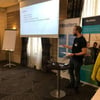The Extreme Speed Track of Financial Markets
Imagine being able to make your investment decisions in microseconds while your competitors react in the same instant. In today’s financial markets, high-frequency trading (HFT) has become a powerful force disrupting traditional trading methods, with statistics showing that it accounts for nearly 60% of U.S. stock market trading volume. In addition, the global high-frequency trading market is expected to exceed $50 billion, underscoring the enormous potential and intense competition in this space. It’s not just a game of numbers, it’s a battle of technology and speed that determines the fate of winners and losers.
Windsor Brokers is a vivid example of this transformation, having invested in AlibabaCloud to reduce latency from 250 milliseconds to 120 milliseconds for connections between Europe and China, providing customers with an unprecedented trading experience. For every millisecond of latency reduction, profitability increases by 0.5%. Against this backdrop, whoever can seize the first opportunity will win the favor of the market! Like on a very fast track, speed and technology will determine the future direction of the financial landscape.
1. Ultra-low latency: timing is everything
Speed is the lifeline of competition at the intersection of finance and technology. For the startup BCB Blockchain, seizing market opportunities means survival and development. As the business of smart city solutions expands, rapidly deploying nodes in China and Asia-Pacific has become a major challenge for them.
Against this backdrop, BCB chose AlibabaCloud, which has a strong presence in the region, as a strategic partner. With Elastic Compute Service (ECS) and Global Accelerator (GA), BCB has successfully reduced connection latency to below industry standards. This transformation has enabled BCB to respond quickly to market changes at critical times, deploying nodes rapidly and ensuring seamless access to its services for local developers.
The ultra-low latency allowed BCB to smoothly bring the technology to market at a critical time for new product launches, which received enthusiastic feedback from users. This advantage not only enhances the user experience but also helps BCB to respond quickly to demand in a rapidly changing market, avoiding potential losses. BCB’s success story amply demonstrates that timing is the key to capturing market opportunities for small businesses.
2. Global Connectivity: Seamless Transaction Experience
In an increasingly globalized business environment, SMBs are under pressure to compete with large enterprises. AlibabaCloud’s global network interconnection solution is designed to address these challenges. With a cloud-native solution based on SD-WAN technology, SMBs can quickly establish a highly resilient, high-quality global network with data privacy guarantees, ensuring that their core business is seamlessly connected to the rest of the world.
● Minute Deployment: Alibaba Cloud's global network and SD-WAN technology simplify the network deployment process, enabling organizations to set up a global network in minutes and respond quickly to market demands.
● Highly Reliable Global Network: Utilizes global infrastructure and redundancy technologies to ensure high network reliability and avoid business loss due to network problems.
● Multi-terminal secure network: Supports the construction of a secure cloud network between multiple devices to ensure the security of data transmission.
● Accelerated Cloud Applications: Provides one-stop cloud application acceleration solutions to enhance work efficiency and response speed, enabling SMBs to stand out in the fierce market competition.
3. High-performance computing: breaks through the traditional
ECS Bare Metal Instance is like a “supercomputer” customized for enterprises. It combines the flexibility of a virtual machine with the computing power of a physical machine, allowing organizations to adapt quickly in a rapidly changing market.
By utilizing high-performance computing, companies can significantly reduce operating costs and improve responsiveness. For example, an e-commerce platform quickly scaled compute resources to enable real-time data analysis and inventory management during the Black Friday sale. A five-fold increase in computing power during peak hours resulted in 50% faster page loads and a greatly improved customer shopping experience. This flexibility and efficiency enables companies to better seize market opportunities and enhance competitiveness.
4. Intelligent Operation and Maintenance: Worry-free backing
With AIops and self-service, enterprises can establish an efficient “unattended” operation and maintenance system, greatly simplifying daily network management and saving operation and maintenance costs.
AIops: Realize the ideal of “unattended” operation and maintenance: Network Intelligence Service (NIS) combines machine learning and knowledge mapping to help enterprises monitor system performance in real-time, automatically identify and solve potential problems, and significantly improve operation and maintenance efficiency.
Self-service: Simplify daily management: Through the self-service platform, enterprise employees can conveniently manage tasks and allocate resources, improving work efficiency and enhancing customer satisfaction.
Conclusion
High-frequency trading technology is bringing new opportunities to SMBs. As technology evolves, businesses can capitalize on low-latency and efficient data processing capabilities to quickly capture market changes. Cloud services play a key role in this trend, providing the necessary computing power and network support to enable SMBs to compete with larger enterprises. In the future, as more organizations embrace cloud technology, we will see more efficient business models and wider market participation.









Top comments (0)